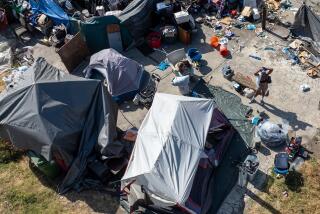The Mentally Ill: Minus Both Housing and Hospitals
The dispossessed weaving across the Los Angeles Theater Center stage in the play “Boesman and Lena” look like the homeless nesting outside the old buildings of the abandoned Spring Street financial district.
The causes of homelessness are not the same. Athol Fugard’s fictional Boesman and Lena are reduced to wandering by a South African state tyranny that dispossessed them from their shantytown to a riverside junkyard for the night. In their poverty and hopelessness, they turn on each other. The play is an example of how poverty--and apartheid--strips humanity from its victims.
Spring Street’s homeless have not been pushed on the streets by cruel, deliberate government action. Drinking, drugs and mental illness sent many of them there.
Yet the play raises important related questions for this city, questions especially pointed in the new theater on the downtown fringe of Skid Row. After driving past our local homeless and then watching “Boesman and Lena,” audiences cannot avoid considering just how much their own government is to blame, even unintentionally, for dumping the homeless on the streets of Los Angeles.
The issue continues to be a matter of public debate. Last week, the Los Angeles County Board of Supervisors, with a major responsibility for care of the homeless, again considered the problem and, on Tuesday, the supervisors approved spending $8.2 million in public funds to provide emergency care and shelter for as many as 12,000 homeless mentally ill people.
The causes of big-city homelessness are many and complicated, a combination of economic change, government cost-cutting, an explosion in drug use and some good intentions gone bad.
In the shift from a basic manufacturing to a technological economy, thousands of unskilled jobs were lost in Los Angeles and elsewhere. Here, for example, the once-thriving tire manufacturing industry closed down. The Reagan Administration’s reduction of social programs, vigorously implemented by a conservative majority on the Board of Supervisors, reduced opportunities for government help to the unskilled unemployed. Drugs, and the violent crime accompanying them, brought more violence and erratic behavior to Skid Row. Seeking safety, the homeless began moving out to the San Fernando Valley, the Westside and other safer neighborhoods. Finally, their numbers are increased annually by the mentally ill, for whom little help exists.
That increase has occurred because well-intentioned state governments in California, New York and elsewhere reduced the size of huge state hospital systems. Justifiably attacked as inhumane warehouses, those hospitals were to be replaced by smaller institutions and community care facilities close to the homes of mentally ill. Halfway houses and state-supervised boarding facilities would permit the mentally ill to live and work in the community while recovering. At the same time, court decisions and state laws assured the rights of the mentally ill--and alcoholics--by eliminating government’s power to shut them up, arbitrarily, in mental hospitals and county jail drunk farms.
Because of recurring state fiscal crises in the 1970s, the community care portion of the reform was never properly implemented. Now, although California and the other urban states are in improved financial condition, the mentally ill are low on the priority scale. Mentally ill citizens continue to be dumped on the streets.
Thus even though nobody meant harm, a form of government action caused homelessness. And now government faces the responsibility of cleaning up the mess. Rebuilding the state hospital system for the most chronically and incurably mentally ill would help. Many mentally ill people sent into the communities are beyond part-time help. They should not be on the streets.
Increased state aid for the mental health departments of Los Angeles and the other urban counties would permit expansion of the neglected community care clinics. Poor and middle-class families burdened with mentally ill relatives know the frustration of trying to find government help after health insurance and personal savings have run out. The Democratic Legislature, the Republican governor, the Democratic mayor of Los Angeles and the Republican Board of Supervisors might rouse themselves from partisan intransigence and agree on a prison site for the Los Angeles area. That would reduce the number of prematurely released felons who now tyrannize some of Skid Row’s worst hotels and streets.
This is all quite expensive and, as Los Angeles County Chief Administrative Officer James Hankla has observed, the poor will not get more money until the middle class and the wealthy--the voters--feel need and reason to support such programs.
One reason is a lesson from the play at the Theater Center Stage, when poverty began to rob Boesman and Lena of their humanity. The numbers of mentally ill on the streets of Los Angeles, homeless, looking like remnants from the inhumane 19th-Century streets of London, rob the community of its humanity.
A sentimental reason is not enough for bottom-line-minded voters. A more pressing one is safety. The homeless, spreading through the community, are not those lovable old Skid Row drunks that San Francisco columnist Herb Caen used to call Skid Rowgues. They need care and, often, confinement. That reason may push their case higher on the state’s list of priorities.
More to Read
The biggest entertainment stories
Get our big stories about Hollywood, film, television, music, arts, culture and more right in your inbox as soon as they publish.
You may occasionally receive promotional content from the Los Angeles Times.










